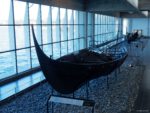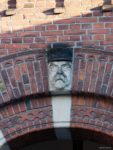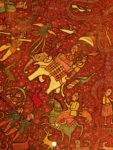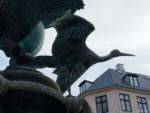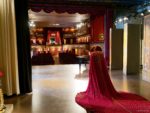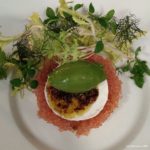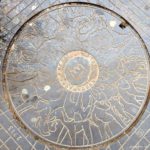To download a printable PDF version (no pictures)
click on this link E2E2019no1.pdf (six A4 pages)
These are links to our photographs of places visited in Copenhagen and Roskilde and Copenhagen restaurants;
there are others in the text

On Saturday morning, eyes still sleep-blurred, we rolled up the shutters at the front of the house. The north field had large white blobs moving around it. Glasses clarified that there were twenty-one white storks with black tails scavenging across the bare earth and stubble, all moving in the same direction, then turning and moving the other way. We watched in fascination. Then we went and had our croissants and coffee (our weekend treat). When we looked again, the storks had moved closer to the house, still in a loose formation. After a while they gathered as if in consultation, whilst exercising their wings. Then one took off, with the others following after thirty seconds. They circled, at one point right above our balcony, then headed off eastwards in the direction of Alsace. We presumed they were on their spring migration from their winter quarters in sub-Saharan Africa.
 Perhaps they brought an optimistic travel message with them. For we have been fretting less about continuing Brexit intransigence, the currently limited ferry services, and the likely delays at the border, than about whether John’s back will recover from its latest set-back in time for the Easter holiday journey to Letchworth. The house in Letchworth must have been looking neglected and unloved, as someone broke the downstairs back bedroom window one night last month. Our back neighbours phoned our side neighbour who phoned Toby, who phoned us and then the police, while John phoned the insurers. Toby said everything seemed OK except for the window. The Hive movement detector in the hall hadn’t sent any messages until Toby went in to the house so, if anyone had climbed through the opened window they had not got far. Nothing seemed to be missing. Perhaps the alarm movement detector in the bedroom had set the alarm off? By evening, thanks to Toby, forensics had pronounced there were no prints inside and the window had been boarded up by the insurance service. And on Brexit Day Mark 1, 29th March, it was re-glazed. So we’ll spend our first week making the house and garden feel loved again, put in some extra video and other security, then enjoy time with Jacob and Leila, followed on Easter Monday by Ann and Derek. And we hope to catch up in between with friends.
Perhaps they brought an optimistic travel message with them. For we have been fretting less about continuing Brexit intransigence, the currently limited ferry services, and the likely delays at the border, than about whether John’s back will recover from its latest set-back in time for the Easter holiday journey to Letchworth. The house in Letchworth must have been looking neglected and unloved, as someone broke the downstairs back bedroom window one night last month. Our back neighbours phoned our side neighbour who phoned Toby, who phoned us and then the police, while John phoned the insurers. Toby said everything seemed OK except for the window. The Hive movement detector in the hall hadn’t sent any messages until Toby went in to the house so, if anyone had climbed through the opened window they had not got far. Nothing seemed to be missing. Perhaps the alarm movement detector in the bedroom had set the alarm off? By evening, thanks to Toby, forensics had pronounced there were no prints inside and the window had been boarded up by the insurance service. And on Brexit Day Mark 1, 29th March, it was re-glazed. So we’ll spend our first week making the house and garden feel loved again, put in some extra video and other security, then enjoy time with Jacob and Leila, followed on Easter Monday by Ann and Derek. And we hope to catch up in between with friends.
When we travelled back here from Letchworth on January 6th, nearly all the cars on the Pride of Burgundy were labelled F, D, B, NL or L. Were the mainland Europeans having a last fling in London while they still knew what regulations and documents applied? As we left the motorways and drove eastwards from Vitry-le-Francois, we noticed bonfire ash, damaged radars and burnt speed restriction signs where the gilets jaunes protestors had previously been encamped, but by our favourite service station stop at Pagny-sur-Meuse, the protestors had erected a super new wooden club house opposite their former site. Back here the protestors have lost the support of the pensioners Helen meets regularly; since Macron suspended his hated overhaul of the pensions and tax system, and launched the Great National Debate, the pensioners no longer feel unheard, and deplore the continuing violence of the hard-line gilets jaunes in Paris and towns like Epinal and Bar-le-Duc. In comparison, the cross-channel chaos of Brexit no longer seems of great significance to the villagers.
Our Mayor’s written annual report was full of gloom at the prospect of small communes like ours being swallowed up and ignored by the large administrative agglomerations of communes. Would this be the last year the Mayor could direct finance towards his evening of New Year Voeux, speeches, champagne and nibbles or the eagerly anticipated lunch for all the over 65s in his commune? As usual his speech at the former was inaudible. But the meal at the latter was as good as ever, with music and dancing; it was just unfortunate that castanet man seated himself at our table, just a few places away, and could not resist loudly accompanying the accordionist. His wife was not with him to restrain his ardour. He said she had fallen and broken her leg. But the most striking New Year festivity his year was Sainte Marguerite’s galette and champagne where, on the dance floor, there were not only the familiar participants in walks, gym, scrabble and games sessions but amazingly costumed, be-jewelled and masked dancers, from the group who parade annually in Venetian Carnival costumes round Remiremont. Very colourful. We were also glad to celebrate Roger and Dorinda’s return to the Vosges (for a week); although John’s fish pie might not sound festive it was delicious, and cake shop specialist Dorinda brought along a lemon sponge to round off our re-union dinner and catch-up.
But, alas, after the festivities and a few snowy walks it was the time for all those exchanged New-Year kisses to extract their revenge with sneezes, sore, throats, colds and inertia (or la gripe – all the French had flu rather than bad colds). John was laid so low that Helen offered to do the shopping one Thursday, but an hour after clearing the snow from the garage and driving off, she found herself sitting in the car park in the next village of Saulcy, shopping list beside her, and no idea of what had happened in the last hour. Rather frightening. Had she been careering madly around in the car knocking down pedestrians? It seemed safest to return home. However, our GP was reassuring, even showing her the textbook description of ictus amnesique. Apparently she could have gone and done all the shopping perfectly efficiently while laying down no memories. And a head scan confirmed there was no damage from a mini stroke. What some people will do to avoid going shopping! After that we spent the time quietly indoors, reading, watching football and organizing and labelling photos of past travels.
Labelling and writing up our Turkey travels in 2009, reminded us of a good collection of Islamic art in Copenhagen, so with our energy finally restored, we planned a short mid-March trip to Copenhagen. We had not got as far as Zealand and Copenhagen on our journey to Jutland and Funen in the summer of 2017, and although four cold March days were not a good time to enjoy the coastline of Zealand, the Viking Ship Museum in Roskilde would be open, and all the museums in Copenhagen, and John had been looking forward to a more exciting taste of New Nordic cuisine than we’d previously found.
So on Monday 18th, we drove over the snowy Bonhomme pass, and took a flight from Basel to Copenhagen. Mastering the airport ticket machines, we caught the modern metro to Kongens Nytorv, and walked up to our Hotel Christian IV, which was a bit shabbier than envisaged, but very pleasant, with the bonus of free coffee, tea, pastries and biscuits in the lounge/ breakfast area at all hours. We’d booked a restaurant on the other side of the town centre, Cofoco, thinking we’d appreciate a good walk after the journey.
And we did indeed enjoy our cold, windy evening stroll along the side of the King’s Garden, past interesting boutiques and shops like the Faraos Cigarer with all its Tintin books and models, restaurants with deserted outdoor tables, the Radhus, Tivoli Gardens and an impressive railway station. Somewhere along our zig-zag route we passed a cake shop display including one with charmingly modelled pigs snuffling across the icing. We wondered what occasion it was suitable for. But however often we later criss-crossed those streets in daylight, camera at the ready, we never found that elusive cake shop again. We particularly enjoyed Cofoco’s salmon/gravlax and the mussel soup and the friendly atmosphere.
As Tuesday was the only sunny day forecast, we changed our plans, and decided to catch a train out to Roskilde and the Viking Ship Museum. Helen, who is easily pleased by such things, was delighted that the train was a double decker; from its top deck it was interesting to see the housing developments including single-storey closely packed small houses, possibly social housing; while John was much taken with the train’s plastic bags to take away with you and dispose of your rubbish. The museum’s five ships, a mix of fishing, trading and longships, had been sunk across one of the channels and piled with stone to prevent an invasion from the sea and the surviving fragments had been painstakingly pieced together on metal frameworks. There was a useful short film and displays about the finds, restoration, and the replicas which had been built over the years. And there was a dramatic room where children could experience the life on board part of a Viking ship in rough seas. 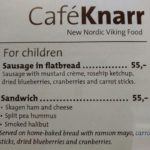 The workshop sessions and boat trips on a replica were summer events, but the café was open for refreshments before we walked back towards town to see the cathedral where many of the Danish monarchs have their tombs. We particularly enjoyed the frescoes, the choir stall carvings and the clock whose action on the hour starts with the dragon’s shrieks.
The workshop sessions and boat trips on a replica were summer events, but the café was open for refreshments before we walked back towards town to see the cathedral where many of the Danish monarchs have their tombs. We particularly enjoyed the frescoes, the choir stall carvings and the clock whose action on the hour starts with the dragon’s shrieks.
The royal tombs were impressive, but the design for the present Queen Margrethe’s tomb was intriguing – a transparent rounded capsule in cast glass holding two supine figures mounted on pillars topped with silver elephant heads. Why the elephants’ heads? Apparently the Danish Order of the Elephant is Denmark’s highest honour, with the monarch as head of the order, and members are from the Royal Family with some foreign heads of state; current Knights of the Elephant include Prince Charles and Emmanuel Macron. After that bit of trivia, we started noticing elephants everywhere, including the Islamic collection and manhole covers.
Back in Copenhagen, we got off the train at the central station (built in 1911) to look at its architecture, especially the chunky columns, heads and folk-art figures, then journeyed on to the Forum metro for our early evening meal at Radio; the restaurant is, not surprisingly, located in the old Radiohus building, and served the best five course meal of our holiday, washed down with Fanefjord Pilsner. This was where we encountered the unappetising-sounding lump fish roe. “It is in season now and every Dane is eating until we are sick of it” the waiter explained as he brought an amuse-bouche of lump fish roe in an onion case, cream, buckwheat and apple. It was tasty, as was the starter of steamed mussels, mussel foam, dill, salsify and parsley. The next delicate course was leeks, Vesterhavs cheese, ransoms and sunflower seeds, followed by a fish course of monkfish wrapped in a thin film of fat from the back of a pig (lardo), mushrooms, cream and a cress garnish. Onto the main of pork cheeks, curly kale, apple, mustard seed, mustard cream and pistachio nuts in halved baby onions. Dessert was unexpected and delicious. Take a deep breath at this point, for their desserts are usually vegetable based, the previous day’s having been beetroot based; today’s was composed from Jerusalem artichoke, French toast, pear, and vanilla ice with a chocolate dust, topped with a sprig of thyme. This was more how we had imagined Nordic cuisine!
On Wednesday we spent most of the day in the Nationalmuseet. We had expected to go fairly quickly through the stone age and bronze age exhibits, having seen other collections, but lingered, amazed by the quality of the finds, – huge polished flints, an aurochs skeleton, beautifully carved amber objects, a decorated funnel beaker bowl from 3200 B.C., bog bodies including Egtved girl in her short cord skirt, a sun chariot, bronze lurs or trumpets, remarkably preserved wagon fragments from Dejbjerg and then a beautiful silver bowl which puzzled us. It was identical to the Gundestrup Cauldron which we’d seen at Aarhus’ Moesgaard Museum two years ago. An attendant was knowledgeable and assured us that theirs was the original but it was sometimes loaned to other museums. He also treated us to a long discourse on Danes in Roman armies (the section where we found him) and misguided stereotypes of Viking warriors. We did visit the other sections of the museum, covering all the later historical periods, Ethnography, and toys (lots of dolls’ houses), but this, for us, had been the most interesting.
Similarly we spent most of the next day in the Davids Samling, just round the corner from our hotel, enjoying the Islamic art. We retreated to the hotel for some coffee and a pastry, before returning to the splendours of calligraphy, ceramics, fabrics (including crimson elephants on a fabulous Kashmir shawl) and tiles, and looking at the special exhibition of Indian photographs from the nineteenth century, and the furnished town house rooms on the first floor.
After that we were ready for a walk outside, taking in the Round Tower, St Nicholas Church, stork fountain, and some expensive shops and cafes (but no cakes with pigs on). That evening we went to Llama, for strong flavours, with its South American food with a Nordic twist. Having waxed lyrical over the food at Radio, perhaps it is sufficient to merely mention Llama’s halibut ceviche, the lime cake and the striking randomly arranged colourful floor tiles.
All too soon it was Friday, and our last day. We had not seen the famous Bridge, the famous Little Mermaid, or the famous art collections. But we felt like wandering round different areas, heading in the general direction of the famous Black Diamond. So we strolled east towards the Yderhavnen waterfront, diverting to see the golden domes of the otherwise seedy-looking and closed Alexander Newsky Kirke and Frederick V’s hideous Marble Church, overlooked by his equestrian statue. Suddenly the street opened up into an open circular area ringed by stately but plain stone buildings guarded by soldiers in busbies. Helen approached one to ask who or what he was guarding. He raised a forbidding hand and shifted his weapon, but, when she she persisted, he conceded through gritted teeth that he was guarding the Crown Prince. Oh dear. Perhaps we should have brought the guide book with us. For this was the Amalienborg Slot, the home of Queen Margrethe. We disappeared rapidly towards the waterfront, with the modern opera house across the water, the renovated warehouses on either side and the bright yellow ferry bus service. Lining Nyhavn, we admired the painted houses and old boats. Further on a raft containing five men in high-vis jackets and a mound of barnacle-encrusted bicycles passed slowly by, preceded by the bubbles of a diver. One somehow doesn’t imagine Danes throwing their bicycles into the waterways.
Ahead of us lay the unprepossessing Black Diamond of the National and University Library, a modern extension of the old Royal Library. John paused to photograph the altogether more quirky Borsen or stock exchange with its Dutch Renaissance gables and spire of entwined tails of four dragons – a fairy-tale building for the men-of-money – and also the alternative small mermaid statue. Then we entered the library and took the escalator up to the fourth floor to look down at the glassed off collections and study tables. The older part of the library is noisy with chattering students and their laptops, and the old card catalogue still had its hand written cards for works by Boethius and later typed cards. We read later that one of the largest book thefts in history happened here between 1968 and 1978, with some 1,600 historical books worth more than fifty million dollars stolen, undetected until 1975, many sold at auction. But when one surfaced at Christie’s in 2003, it was discovered that the thief was a director of the library’s oriental department who had died in January 2003 and whose family had become careless about selling the books. 1,500 books were recovered. Never trust a librarian! After a couple of very expensive lattes in the ground floor cafe, we walked round to the Parliament building, which was closed to the public, hearing sounds of protests over the New Zealand mosque shootings; one of the attendants told us with regret that he thought Denmark is becoming much less tolerant with growing anti-Muslim feelings.
In another courtyard we went into the former Royal Stables, where the Court Theatre was established (for court audiences only) in 1767. Despite having closed in 1881 (as many theatres did after a major fire in a Vienna theatre), it still had a great atmosphere with its red and gold decor, and we could wander freely through the royal box, across the stage, main dressing room and auditorium and try out the wind and thunder machines. After that Helen went to the nearby Danish Jewish Museum (designed by Daniel Libeskind within the old Royal Boat House) and John visited the old castle walls under the Christiansborg Palace.
Afterwards, we walked round the Parliament and Palace buildings, but did not recognize any of the Borgen TV series settings. We crossed back from the island, paused in the elegant Georg Jensen shop (alas they no longer seem to sell the Prism cutlery set from which John had bought a single place setting back in the sixties – what an unusual student purchase!), and explored the Sankt Petri area. It was good to recharge our batteries back at the hotel over tea and coffee (and Helen caught up on all Will, Kate, Harry and Meghan’s recent engagements in the lounge’s Hello magazines), before we went for our last meal at Koefoed. Guess what the starter there was? Yes, lump fish roe.
And what was John’s last Copenhagen photo on the way to the metro and airport next morning? A manhole cover with elephants.


